Monica Eng’s SNAP Challenge food stamp diary and shopping strategy
By Monica Eng

Monica Eng’s SNAP Challenge food stamp diary and shopping strategy
By Monica EngBreakfast: Two fried eggs in sauteed kale, two tortillas, 1 tbsp sauerkraut, beans and a cup of tea.
This meal mirrors what I normally eat for breakfast, but I had to go with factory farmed chicken eggs (99 cents a dozen) because eggs from chickens who live on pasture and aren’t fed genetically modified grain cost me $5 to $6 a carton. I also had to swap my morning coffee and cream for Aldi tea. It’s actually pretty tasty and I kept some of the concentrated tea at the bottom of the cup to make iced tea later.
Growing up in a half Puerto Rican family, I was blessed with a love for good rice and beans, and – more importantly – a grandmother who taught me how to cook them. The secret is a good sofrito, which you would ideally make from scratch with garlic, onion, sweet peppers and cilantro.
But a great substitute is fresh sofrito sold in area stores like Cermak Produce.
Unfortunately we had to go with a jarred version, which didn’t give up much flavor, so I added extra garlic, salt and sambal, which is technically OK for our WBEZ SNAP challenge because they are condiments.
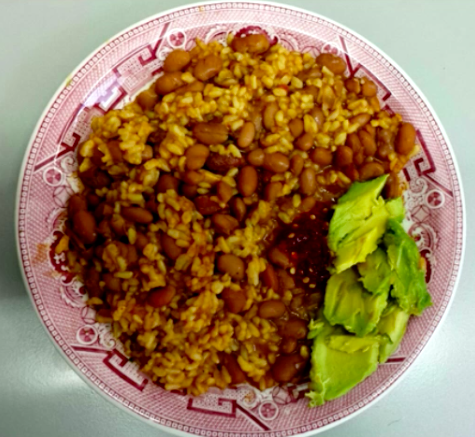
Snack: Piece of toast smeared with peanut butter and sliced apple.
As much as I wanted a sweet from the vending machines, I turned to the office toaster instead. Now that apples are in season, they are super affordable and paired with the protein-packed peanut butter they recall the peanut-sprinkled taffy apples of my childhood.
Snack: Piece of toast smeared with peanut butter and a nino banana
These tiny bananas delight my kids, but they’re also good for the pocketbook when, in this case, I found very ripe ones discounted at a cost of 99 cents for 18 at Pete’s. I like to eat them on a peanut butter and banana sandwich like a hot dog.
Dinner: Raw kale tossed with lentils, rice and a mustard vinaigrette (vinegar, oil, dijon mustard).
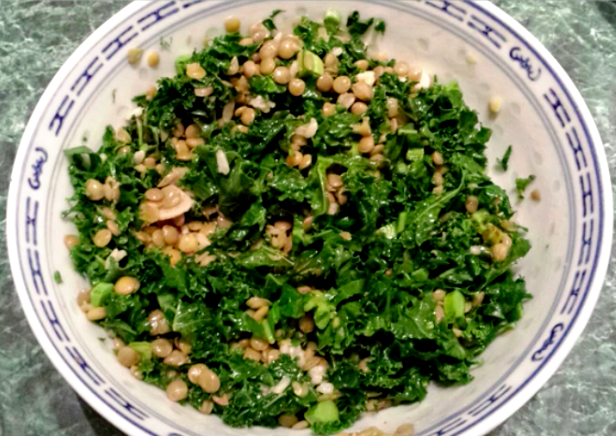
On a hot September night, this made for a perfect cool dinner. I cooked the lentils in garlicky, salted water until just soft and then tossed them with rice, chopped kale and a mustard vinaigrette (olive oil, vinegar and mustard). My daughter not only took seconds for dinner but asked me to pack more for her school lunch the next day. I wished my budget would have allowed for some chopped red pepper and scallions to brighten up the color and flavor but that wasn’t in the budget.
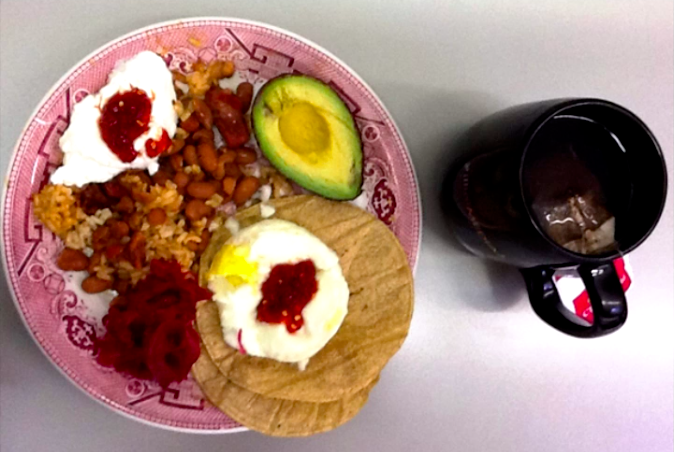
Tuesday food diary
Breakfast: Two eggs poached in a mug, two tortillas, rice and beans, sauerkraut, half avocado and cup of tea.
When you’ve got kids to get dressed and off to school, you realize why so many people reach for pricey convenience foods. In our rush to get my daughter to early morning sports practice and a teenager to high school, I had no time to make breakfast. So I gathered all my ingredients and brought them to work. There, I microwave-poached a couple of eggs in a mug, heated tortillas and beans and made a cup of tea. Most people probably don’t have office kitchens as well-equipped as WBEZ’s and so missing breakfast at home might mean unhealthy convenience foods or zippo.
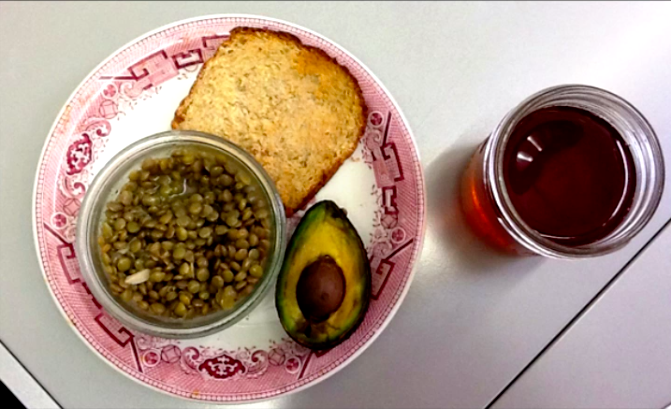
Lunch: Bowl of lentils tossed in mustard vinaigrette, half avocado and piece of toast.
I can do lentils for another day but I can see how they might get a little monotonous after a while.
The Intelligentsia coffee in the WBEZ kitchen was beckoning me but I’m sticking to my Aldi inexpensive tea that I turned into iced tea for this afternoon.
When I need something small, sweet, a little fatty and nutritious, this is my go to snack.
When it comes to cheap sources of nutritious protein, eggs are one of your best bets. Once considered an unhealthy food that should be limited, more recent studies have vindicated its health profile. Plus, you
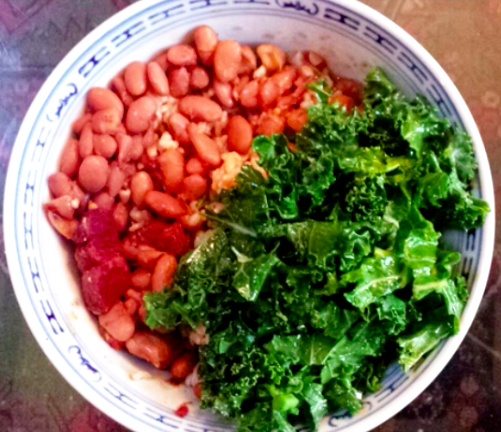
If my meals are starting to look a little repetitive, it’s because they are – and that’s how they began to taste. As much as I love rice, beans and kale, I was longing for some of the grilled chicken and watermelon that the rest of my family was feasting on at the dinner table.
Monica’s SNAP shopping list
Total cost: $9.99
Pork hock $2.37
(15 oz hock cost 9.50 but we split it, then halved the price again to account for the double value given to SNAP benefits at 61st Street Farmers Market.
6 eggs .50
(full carton at Pete’s cost 99 cents)
12 oz dry beans .70
(I bought a plastic carton for $1.53 and used a little less than half to soak and cook)
Kale bunch $1.25
(we bought 2 for $5 at the market that doubled SNAP dollars)
8 oz dry lentils .65
4 oz sofrito .75
2 peaches .20
(bruised peaches cost 5 for $1 at 61st Street where SNAP gets double value)
2 apples .69
(price at Pete’s)
6 ninos bananas .33
(bought 19 for 99 cents)
2 tbsp peanut butter .20
(container cost $2.59)
1/3 loaf bread .83
(whole loaf was $2.59)
2.5 cups brown rice .35
(bag cost 69 cents, I made half)
12 tortillas .25
(bought at Atotonilco Tortilleria on 47th Street)
7 oz Greek yogurt $1
(Fage was on sale for $1 each)
Avocado .79
(Pete’s price)
3 tea bags .06
(Aldi’s Benner Classic Blend tea costs $1.89 for 100 bags)
3 tbsp sauerkraut .06
(I made 2 huge jars of sauerkraut with one $1 cabbage head and salt)
SNAP Recap
At the end of the two days, we didn’t exactly know what it’s like to live on food stamps. But we got a taste, and it wasn’t very pleasant. It was time consuming, stressful and starting to get monotonous. We saw a world full of food that was beyond our reach and became more aware of how important motivation, consumer education and cooking knowledge is to creating healthy meals on a budget. We can only imagine how much harder it would’ve been without our cars, kitchen equipment and access to great products.
The food stamp debate is a heated one with strong arguments on both sides. But most people who look at federal food consumption and health statistics tend to agree that the nation would be better off if we could all manage to regularly buy, cook and eat nutritious foods.
For anyone who wants to take the SNAP challenge during September, here are the rules from the Greater Chicago Food Depository:
Each person should spend a set amount for food and beverages during the Challenge week. That amount is $35/week or $5/day for all food and beverage.
All food purchased and eaten during the Challenge week, including fast food and dining out, must be included in the total spending.
During the Challenge, only eat food that you purchase for the project. Do not eat food that you already own (this does not include spices and condiments).
Avoid accepting free food from friends, family, or at work, including at receptions, briefings, or other events where food is served.
Keep track of receipts on food spending and take note of your experiences throughout the week.
- Invite others to join you, including co-workers, reporters, chefs, or other elected officials.
Monica Eng is a WBEZ producer. Follow her @monicaeng.